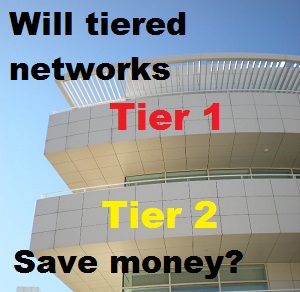In what could be the first consumer driven attempt in California to push down rising health care costs Anthem Blue Cross is flagging facilities in California that are unwilling to pass on deep discounts to its members. Anthem Blue Cross has introduced Tiered Networks into several counties in California with its new ACA compliant health plans in hopes that subscribers will choose less costly facilities.
Tiered network introduced with EPOs
In the counties of San Francisco, Los Angeles, Orange and San Diego, Anthem Blue Cross has separated their contracted provider facilities like hospitals into tiered groups. Tier 1 is the most favored status which provides the member with smallest cost for procedures or services. Tier 2 facilities will cost the member, and potentially Anthem Blue Cross, more money for the same services provided by Tier 1 facilities. The new tiered networks from Blue Cross sit along side Anthem’s Exclusive Provider Organizations (EPOs) in the same counties.
From the Anthem Blue Cross outline of coverage,
“Tier 1 Facilities are preferred participating facilities that have agreed to accept deeper discounts which we can then pass along to the member (20% coinsurance). Tier 2 facilities have agreed to participate in our network but have not agreed to accept deeper discounts. Counties with tiered facility networks: San Francisco, Los Angeles (North and South), Orange, and San Diego Counties.”
Overview of available Anthem Blue Cross California ACA Plans
Hospitals get Tier 1
Within San Francisco County, Blue Cross only shows three tier 1 facilities: Chinese Hospital, UCSF Children’s Hospital and UCSF Medical Center. All the other facilities had no designation leaving one to believe that they were tier 2. This included numerous psychiatric, eye and surgery centers. In Los Angeles County, the tier 1 facilities consist primarily of general hospitals and medical centers.
Smaller facilities are tier 2
As a general rule, smaller specialized facilities in the area of infusion therapy, hospice, skilled nursing, surgery centers and diagnostic imaging have proven to have lower prices than a general hospital. At least that is the general conclusion from Anthem Blue Cross cost of care estimator. When the online tool was working, the cost for numerous procedures such as an MRI or arthroscopic knee surgery were always more expensive at a large hospital. Anthem Blue Cost Estimator online tool and The roots of health care costs by Anthem Blue Cross which cites expensive diagnostic imaging as a cause.
What determined the tier?
Anthem Blue Cross doesn’t provide any specifics as to how they determined tier 1 from tier 2 facilities. Was it based on a straight negotiated discount from the list price or were net prices considered? A 50% discount sounds better than a 10% discount. But if the larger discount was given on an inflated list price, the 10% discount may still yield a better net price to the consumer.
Is this a first step?
It’s great that Anthem Blue Cross is identifying facilities that might provide lower health care costs to consumers. After all, it is the insurance companies that are negotiating, one would assume, the lowest price possible. Without additional data to support the claim that tier 1 facilities are actually charging less for the same procedure as a designated tier 2 facility the consumer still doesn’t have enough information to make an informed choice. While I have no doubt that Anthem Blue Cross wants to control the costs of health care services, simply designating certain facilities with a star of approval for best rates is only a half-step.
Lots of consumer questions
How do we know that the facilities, which all seem to be major hospitals in competition with smaller facilities which have lower operating costs, haven’t cut a deal with Anthem Blue Cross for tier 1 designation to drive in more business? Are the doctors, who make the referral and arrange for procedures, aware of the tiered networks? Will the doctors be liable for the extra cost to the plan member if they send a patient to a tier 2 facility when a presumably less expensive tier 1 provider was available?
Will tiers translate into lower costs?
Anthem’s attempt to reward facilities that offer lower prices and attempt to hold down the cost of rising health care costs is admirable. Unfortunately, there doesn’t seem to be enough information to determine if the tiered network system will actually translate into lower costs for the patient.


